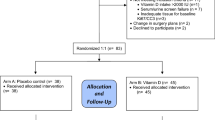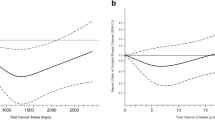Abstract
Endocrine action of vitamin D and its role in calcium homeostasis and bone health are well known. The discovery that breast epithelial cells possess the same enzyme system as the kidney, permitting local manufacture of active vitamin D (1,25 dihydroxyvitamin D, or 1,25[(OH)2D]) from circulating precursors 25 hydroxyvitamin D [25(OH)D], has suggested an autocrine role for vitamin D, as well. Preclinical and ecologic studies support a role of vitamin D in prevention of breast cancer. Correlative study results of vitamin D intake or measurement of 25(OH)D, the long-lived precursor, are mixed but suggest a protective effect in premenopausal women. The large Women’s Health Initiative failed to show any reduction in breast cancer incidence in postmenopausal women with a modest amount of vitamin D supplementation. Lack of effect, however, may have been related to trial design. A recent report also suggests that vitamin D may reduce breast cancer recurrence and mortality. Finally, vitamin D is being investigated as a means to reduce aromatase inhibitor-induced joint symptoms.


Similar content being viewed by others
References
Papers of particular interest, published recently, have been highlighted as: •• Of major importance
Holick MF, Chen TC: Vitamin D deficiency: a worldwide problem with health consequences. Am J Clin Nutr 2008, 87:1080S–1086S
Holick MF: The photobiology of vitamin D and its consequences for humans. Ann N Y Acad Sci 1985, 453:1–13.
Mullin GE, Dobs A: Vitamin D and its role in cancer and immunity: a prescription for sunlight. Nutr Clin Pract 2007, 22:305–322.
Eaton SB: Paleolithic lifestyle and bone. Osteoporos Int 2006, 17:S125–S127.
Moore C, Murphy MM, Keast DR, Holick MF: Vitamin D intake in the United States. J Am Diet Assoc 2004, 104:980–983.
Lips P, Hosking D, Lippuner K, et al.: The prevalence of vitamin D inadequacy amongst women with osteoporosis: an international epidemiological investigation. J Intern Med 2006, 260:245–254.
Holick MF: High prevalence of vitamin D inadequacy and implications for health. Mayo Clin Proc 2006, 81:353–373.
Malabanan A, Veronikis IE, Holick MF: Redefining vitamin D insufficiency [letter]. Lancet 1998, 351:805–806.
Thomas MK, Lloyd-Jones DM, Thadhani RI, et al.: Hypovitaminosis D in medical inpatients. N Engl J Med 1998, 338:777–783.
Holick MF: Vitamin D deficiency. N Engl J Med 2007, 357:266–281.
Bischoff-Ferrari HA, Giovannucci E, Willett WC, et al.: Estimation of optimal serum concentrations of 25-hydroxyvitamin D for multiple health outcomes. Am J Clin Nutr 2006, 84:18–28.
Welsh J: Targets of vitamin D receptor signaling in the mammary gland. J Bone Miner Res 2007, 22:V86–V90.
Høyer-Hansen M, Bastholm L, Szyniarowski P, et al.: Control of macroautophagy by calcium, calmodulin-dependent kinase kinase-beta, and Bcl-2. Mol Cell 2007, 25:193–205.
O’Kelly J, Uskokovic M, Lemp N, et al.: Novel Gemini-vitamin D3 analogue inhibits tumor cell growth and modulates the Akt/mTOR signaling pathway. J Steroid Biochem Mol Biol 2006, 100:107–116.
Kemmis CM, Salvador SM, Smith KM, et al.: Human mammary epithelial cells express CYP27B1 and are growth inhibited by 25-hydroxyvitamin D-3, the major circulating form of vitamin D-3. J Nutr 2006, 136:887–892.
Peng X, Hawthorne M, Vaishnav A, et al: 25-Hydroxyvitamin D(3) is a natural chemopreventive agent against carcinogen induced precancerous lesions in mouse mammary gland organ culture. Breast Cancer Res Treat 2009, 113:31–41.
•• Grant WB: An estimate of premature cancer mortality in the U.S. due to inadequate doses of solar ultraviolet-B radiation. Cancer 2002, 94:1867–1875. This article demonstrates that breast cancer mortality is higher in areas of low sunlight experience.
Garland FC, Garland CF, Gorham ED, Young JF: Geographic variation in breast cancer mortality in the United States: a hypothesis involving exposure to solar radiation. Prev Med 1990, 19:614–622.
Blot WJ, McLaughlin JK: Geographic patterns of breast cancer among American women. J Natl Cancer Inst 1995, 87:1819–1820.
Mohr SB, Garland CF, Gorham ED, et al.: Relationship between low ultraviolet B irradiance and higher breast cancer risk in 107 countries. Breast J 2008, 14:255–260.
Gorham ED, Garland FC, Garland CF: Sunlight and breast cancer incidence in the USSR. Int J Epidemiol 1990, 19:820–824.
John EM, Schwartz GG, Dreon DM, Koo J: Vitamin D and breast cancer risk: the NHANES I Epidemiologic follow-up study, 1971–1975 to 1992. National Health and Nutrition Examination Survey. Cancer Epidemiol Biomarkers Prev 1999, 8:399–406.
Shin MH, Holmes MD, Hankinson SE, et al.: Intake of dairy products, calcium, and vitamin d and risk of breast cancer. J Natl Cancer Inst 2002, 94:1301–1311.
Knight JA, Lesosky M, Barnett H, et al.: Vitamin D and reduced risk of breast cancer: a population-based case-control study. Cancer Epidemiol Biomarkers Prev 2007, 16:422–429.
McCullough ML, Rodriguez C, Diver WR, et al.: Dairy, calcium, and vitamin D intake and postmenopausal breast cancer risk in the Cancer Prevention Study II Nutrition Cohort. Cancer Epidemiol Biomarkers Prev 2005, 14:2898–2904.
Welsh J, Wietzke JA, Zinser GM, et al.: Impact of the Vitamin D3 receptor on growth-regulatory pathways in mammary gland and breast cancer. J Steroid Biochem Mol Biol 2002, 83:85–92.
Lowe L, Hansen CM, Senaratne S, Colston KW: Mechanisms implicated in the growth regulatory effects of vitamin D compounds in breast cancer cells. Recent Results Cancer Res 2003, 164:99–110.
Curran JE, Vaughan T, Lea RA, et al.: Association of A vitamin D receptor polymorphism with sporadic breast cancer development. Int J Cancer 1999, 83:723–726.
Whitfield GK, Remus LS, Jurutka PW, et al.: Functionally relevant polymorphisms in the human nuclear vitamin D receptor gene. Mol Cell Endocrinol 2001, 177:145–159.
•• Garland CF, Gorham ED, Mohr SB, et al.: Vitamin D and prevention of breast cancer: pooled analysis. J Steroid Biochem Mol Biol 2007, 103:708–711. This article provides a pooled analysis of low breast cancer risk with higher 25(OH)D levels.
Bertone-Johnson ER, Chen WY, Holick MF, Hollis BW, Colditz GA, Willett WC, Hankinson SE. Plasma 25-hydroxyvitamin D and 1,25-dihydroxyvitamin D and risk of breast cancer. Cancer Epidemiol Biomarkers Prev 2005, 14:1991–1997.
Lowe LC, Guy M, Mansi JL, Peckitt C, Bliss J, Wilson RG, Colston KW. Plasma 25-hydroxy vitamin D concentrations, vitamin D receptor genotype and breast cancer risk in a UK Caucasian population. Eur J Cancer 2005, 41:1164–1169.
Berube S, Diorio C, Masse B, et al.: Vitamin D and calcium intakes from food or supplements and mammographic breast density. Cancer Epidemiol Biomarkers Prev 2005, 14:1653–1659.
Boyd NF, Byng JW, Jong RA, et al.: Quantitative classification of mammographic densities and breast cancer risk: results from the Canadian National Breast Screening Study. J Natl Cancer Inst 1995, 87:670–675.
Diorio C, Berube S, Byrne C, et al.: Influence of insulin-like growth factors on the strength of the relation of vitamin D and calcium intakes to mammographic breast density. Cancer Res 2006, 66:588–597.
Byrne C, Colditz GA, Willett WC, et al.: Plasma insulin-like growth factor (IGF) I, IGF-binding protein 3, and mammographic density. Cancer Res 2000, 60:3744–3748.
Diorio C, Pollak M, Byrne C, et al.: Insulin-like growth factor-I, IGF-binding protein-3, and mammographic breast density. Cancer Epidemiol Biomarkers Prev 2005, 14:1065–1073.
Yu H, Shu XO, Li BD, et al.: Joint effect of insulin-like growth factors and sex steroids on breast cancer risk. Cancer Epidemiol Biomarkers Prev 2003, 12:1067–1073.
Knight JA, Vachon CM, Vierkant RA, et al.: No association between 25-hydroxyvitamin D and mammographic density. Cancer Epidemiol Biomarkers Prev 2006, 15:1988–1992.
Ursin G, Parisky YR, Pike MC, Spicer DV: Mammographic density changes during the menstrual cycle. Cancer Epidemiol Biomarkers Prev 2001, 10:141–142.
Brisson J, Bérubé S, Diorio C, et al.: Synchronized seasonal variations of mammographic breast density and plasma 25-hydroxyvitamin D. Cancer Epidemiol Biomarkers Prev 2007, 16:929–933.
•• Prentice RL, Anderson GL: The women’s health initiative: lessons learned. Annu Rev Public Health 2008, 29:131–150. This article discusses a negative WHI trial showing no effect of vitamin D and calcium intake on breast cancer incidence.
•• Lappe JM, Travers-Gustafson D, Davies KM, et al.: Vitamin D and calcium supplementation reduces cancer risk: results of a randomized trial. Am J Clin Nutr 2007, 85:1586–1591. This article discusses a randomized trial showing that incidence of cancer is lower with higher doses of calcium and vitamin D.
Heaney RP: The Vitamin D requirement in health and disease. J Steroid Biochem Mol Biol 2005, 97:13–19.
Garland CF, Gorham ED, Mohr SB, et al: Vitamin D and prevention of breast cancer: pooled analysis. J Steroid Biochem Mol Biol 2007, 103:708–711.
Holick MF, Chen TC: Vitamin D deficiency: a worldwide problem with health consequences. Am J Clin Nutr 2008, 87:1080S–1086S.
Heaney RP, Davies KM, Chen TC, et al.: Human serum 25-hydroxycholecalciferol response to extended oral dosing with cholecalciferol. Am J Clin Nutr 2003, 77:204–210.
Dawson-Hughes B, Heaney RP, Holick MF, et al.: Estimates of optimal vitamin D status. Osteoporos Int 2005, 16:713–716.
Freedman DF, Dosemeci M, McGlynn K: Sunlight and mortality from breast, ovarian, colon, prostate, and non-melanoma skin cancer: a composite death certificate based case-control study. Occup Environ Med 2002, 59:257–262.
Grant WB: Geographic variation of prostate cancer mortality rates in the United States: implications for prostate cancer risk related to vitamin D. Int J Cancer 2004, 111:470–471.
Hanchette CL, Schwartz GG: Geographic patterns of prostate cancer mortality. Evidence for a protective effect of ultraviolet radiation, Cancer 1992, 70:2861–2869.
John EM, Schwartz GG, Koo J, Van Den BD, Ingles SA: Sun exposure, vitamin D receptor gene polymorphisms, and risk of advanced prostate cancer. Cancer Res 2005, 65:5470–5479.
Robsahm TE, Tretli S, Dahlback A, Moan J: Vitamin D3 from sunlight may improve the prognosis of breast-, colon- and prostate cancer (Norway). Cancer Causes Control 2004, 15:149–158.
•• Goodwin PJ, Ennis M, Pritchard KI, et al.: Prognostic effects of 25-hydroxyvitamin D levels in early breast cancer: J Clin Oncol 2009, 27:3757–3763. This study shows that lower levels of vitamin D in blood are associated with a higher risk of breast cancer recurrence.
Brodie AM, Njar VC: Aromatase inhibitors and breast cancer. Semin Oncol 1996, 23:10–20.
Howell A, Cuzick J, Baum M, et al.: Results of the ATAC (Arimidex, Tamoxifen, Alone or in Combination) trial after completion of 5 years’ adjuvant treatment for breast cancer. Lancet 2005, 365:60–62.
Coates AS, Keshaviah A, Thürlimann B, et al.: Five years of letrozole compared with tamoxifen as initial adjuvant therapy for postmenopausal women with endocrine-responsive early breast cancer: update of study BIG 1-98. J Clin Oncol 2007, 25:486–492.
Crew KD, Greenlee H, Capodice J, et al.: Prevalence of joint symptoms in postmenopausal women taking aromatase inhibitors for early-stage breast cancer. J Clin Oncol 2007, 25:3877–3883.
Partridge AH, LaFountain A, Mayer E, et al.: Adherence to initial adjuvant anastrozole therapy among women with early-stage breast cancer. J Clin Oncol 2008, 26:556–562.
Dent S, DeValentin T, Vandermeer L, et al.: Long-term toxicities in women with early stage breast cancer treated with aromatase inhibitors: data from a tertiary care center [abstract]. Breast Cancer Res Treat 2006, 100:4057.
•• Khan QJ, Reddy PS, Kimler BF, et al.: Effect of vitamin D supplementation on serum 25-hydroxy vitamin D levels, joint pain, and fatigue in women starting adjuvant letrozole treatment for breast cancer. Breast Cancer Res Treat 2009 Aug 5 (Epub ahead of print). This article discusses vitamin D supplementation is associated with reduce disability from joint pain from AIs.
Fabian CJ, Kimler BF, PhillipsT, Zalles CM: Levels of 25-hydroxy-vitamin D in pre-menopausal women at high risk for development of breast cancer. Cancer Res 2009, 69: 5079.
Khan QJ, Reddy PS, Kimler BF, et al.: A prospective study to determine the prevalence of hypovitaminosis D in women with early stage breast cancer treated with an aromatase inhibitor and the benefit of vitamin D supplementation on musculoskeletal symptoms and overall QOL [abstract]. Breast Cancer Res Treat 2007, 1:6075.
Neuhouser ML SorensenB, Hollis BW, et al.: Vitamin D insufficiency in a multiethnic cohort of breast cancer survivors Am J Clin Nutr 2008, 88:133–139.
Disclosure
No potential conflicts of interest relevant to this article were reported.
Author information
Authors and Affiliations
Corresponding author
Rights and permissions
About this article
Cite this article
Khan, Q.J., Kimler, B.F. & Fabian, C.J. The Relationship Between Vitamin D and Breast Cancer Incidence and Natural History. Curr Oncol Rep 12, 136–142 (2010). https://doi.org/10.1007/s11912-010-0081-8
Published:
Issue Date:
DOI: https://doi.org/10.1007/s11912-010-0081-8




